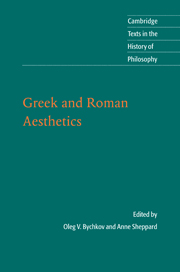Book contents
- Frontmatter
- Contents
- Preface
- Introduction
- Chronology
- Further reading
- Note on the texts and the translations
- Greek and Roman Aesthetics
- Gorgias
- Plato
- Xenophon
- Aristotle
- Philodemus
- Cicero
- Seneca
- Longinus
- Philostratus
- Philostratus the Younger
- Aristides Quintilianus
- Plotinus
- Augustine
- Proclus
- Index
- CAMBRIDGE TEXTS IN THE HISTORY OF PHILOSOPHY
Aristotle
Published online by Cambridge University Press: 05 June 2012
- Frontmatter
- Contents
- Preface
- Introduction
- Chronology
- Further reading
- Note on the texts and the translations
- Greek and Roman Aesthetics
- Gorgias
- Plato
- Xenophon
- Aristotle
- Philodemus
- Cicero
- Seneca
- Longinus
- Philostratus
- Philostratus the Younger
- Aristides Quintilianus
- Plotinus
- Augustine
- Proclus
- Index
- CAMBRIDGE TEXTS IN THE HISTORY OF PHILOSOPHY
Summary
Poetics
1.1447a–19.1456b
Let us discuss poetry in general and its species. We must discuss what each species of poetry can do, how plots should be put together to produce a fine piece of work, the number and nature of the component parts and everything else that belongs to the same field of enquiry. Let us begin in the natural way, with first principles.
Epic, tragedy, comedy, dithyramb and most music for the pipe or the lyre are all, in general, types of imitation. They differ from each other in three ways: in the media used, in the objects of imitation, and in the mode or manner of imitation. Some people use colours and shapes to make imitative likenesses of various things (some achieve this through art, others through practice), while others use the voice as the medium of imitation. Similarly all the arts I have mentioned use rhythm, words and melody as the media of imitation, either separately or together. For example, music for the pipe or the lyre and any other arts that can produce the same effect, such as music for pan-pipes, use only melody and rhythm, while dancing uses rhythm by itself, without melody, for dancers imitate characters, emotions and actions by the rhythm of their movements. To date there is no general name for the arts which use only unaccompanied words or just words and metre, whether a mixture of metres or one particular type of metre.
- Type
- Chapter
- Information
- Greek and Roman Aesthetics , pp. 79 - 108Publisher: Cambridge University PressPrint publication year: 2010

